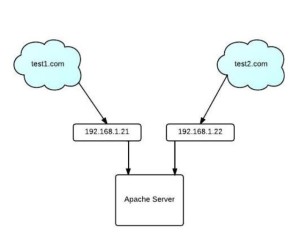The ServerName and ServerAlias is more like a company’s internal phone list. Your webserver is the switchboard; it will accept all incoming connections to the server. Then the client/caller will tell them what name they’re looking for, and it will look in the Apache configuration for how to handle that name. If the name isn’t listed as a ServerName/ServerAlias in the apache configuration, apache will always give them the first VirtualHost listed. Or, if there’s no VirtualHost at all, it will give the same content no matter what hostname is given in the request.
So, step by step for a normal connection:
1. You type “http://www.example.com” into your browser.
2. Your computer asks its DNS resolver which IP address it should use when it wants to talk to www.example.com.
3. Your computer connects to that IP address, and says that it wants to talk to www.example.com (that’s the Host:header in HTTP).
4. The webserver looks at its configuration to figure out what to do with a request for content from www.example.com.
Any one of the following may happen:
- www.example.com is listed as a ServerName or ServerAlias for a VirtualHost – if so, then it will use the configuration for that VirtualHost to deliver the content.
- The server doesn’t have any VirtualHosts at all – if so, then it will use the configuration in its httpd.conf to deliver the content.
- The server has VirtualHosts but www.example.com isn’t listed in any of them – if so, the first Virtualhost in the list will be used to deliver the content.
<VirtualHost *:80>
# Admin email, Server Name (domain name), and any aliases
ServerAdmin [email protected]
ServerName abc.com
ServerAlias example.com
…


